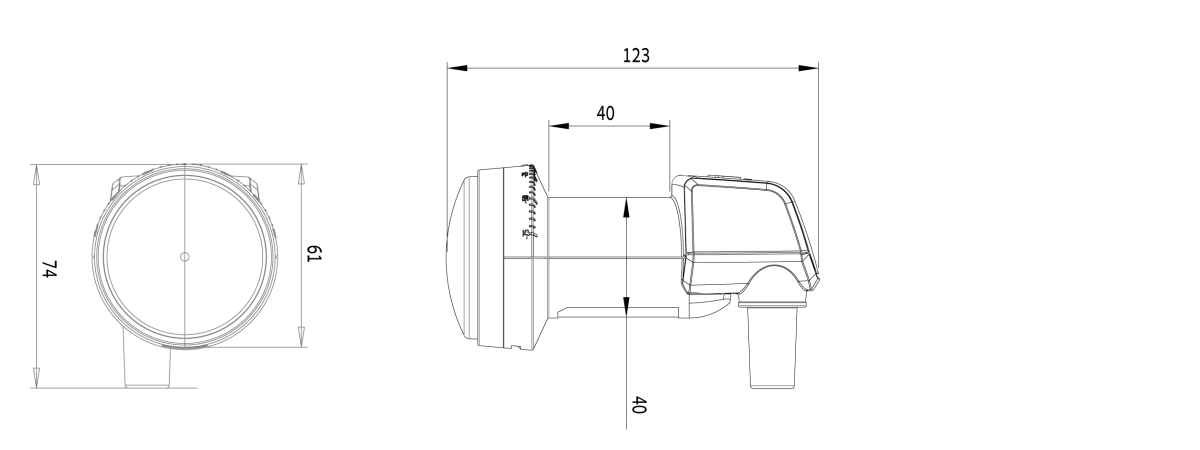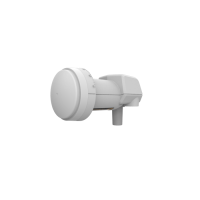This Unicable II® LNB is based on digital channel stacking technology and enables installations with up to 32 satellite receivers connected over a single coax cable and using the EN50494/EN50607 protocols - also known as ‘Dynamic’ mode. In this mode, the satellite receivers can access any transponder of the received satellite. Alternatively, it can be configured to down-convert a set of 32 transponders (or more, depending on the bandwidth of the desired transponders) and stack them over its output - also known as ‘Static’ mode. This mode allows an unlimited number of receivers to be connected and access these transponders.
Digital channel stacking technology uses fast wideband analog to digital converters and applies digital signal processing to select desired transponder channels, up convert them and stack them as IF signals over the output port. Unicable II® LNBs offer a cost effective and elegant solution for distributing the satellite signals to multiple set-top-boxes (multiroom) or multi-tuner PVRs over existing cabling hence significantly reducing cost and complexity of the installation at the subscribers’ homes. The Static mode, allowing an unlimited number of receivers to be connected to the LNB over a single cable distribution, makes installations in buildings, campuses and closed communities substantially cheaper and simpler than ever before. The operating mode (dynamic/static), output power level, channel bandwidth, UB frequencies and dish alignment mode are all programmable and can be configured and updated in the field using Inverto’s SatPal™ Controller*.
The LNB can be powered over a connected STB or by an AC/DC adapter over a power inserter in case the STB is unable to provide the necessary power. Unicable II® is backward compatible, fully compliant with both EN50494 and EN50607 standards and integrates seamlessly into EN50494-only or mixed EN50494/EN50607 installations of compatible STBs, Next Generation PVRs and HGWs.
For more information on the Unicable II™ technology and its advantages please refer to: www.inverto.tv/what-is-unicable-2
For more information on the SatPal™ technology and its advantages please refer to: www.inverto.tv/satpal
Main Features:
- Low Phase Noise UHD DVBS2 compliant
- Low Noise Figure
- Very high cross-polarization isolation
- Programmable configuration
- Dish alignment mode with fixed gain
- Low power consumption
*SatPal™ Controller not included, sold separately as an optional accessory
| Technical specifications | |
|---|---|
| Input frequency range | 10.7 GHz ~ 12.75 GHz |
| Noise figure |
1 dB max. |
| LO frequency |
10.4 GHz |
| LO frequency accuracy @ 25° C |
1.0 MHz max. |
| LO initial accuracy | 500 kHz max. |
| LO phase noise @ 1 kHz | -60 dBc / Hz max. |
| LO phase noise @ 10 kHz |
-80 dBc / Hz max. |
| Conversion gain |
55 dB min. |
| Gain variation (over full band) | ±0.75 dB/UB max. |
| Image rejection |
40 dB min. |
| 1 dB compression point (@ output) | 0 dBm min. |
| Cross polarization isolation | 22 dB min. |
| Output VSWR |
2.5 : 1 |
| Current consumption |
280 mA max. @ 18 VDC |
| Operating temperature |
-30 °C ~ +60 °C |
| Output impedance |
75 Ω |
| Output connector type |
F-Type (female) |
| Weight | 152.5 g |
| Unicable II™ (dCSS) port specifications | |
| Bandwidth User Band |
Configurable, 10 MHz ~ 64 MHz (default 36 MHz) |
| Output power level (dSCR/dCSS with AGC) | -25 dBm (83 dBuV) +/-1 dB |
| Number of User Bands |
Up to 32 User Bands |
| Standard configuration |
32 UBs in dynamic mode: |
| CH1 1210MHz (EN50494+EN50607) | |
| CH2 1420MHz (EN50494+EN50607) | |
| CH3 1680MHz (EN50494+EN50607) | |
| CH4 2040MHz (EN50494+EN50607) | |
| CH5 984MHz (EN50494+EN50607) | |
| CH6 1020MHz (EN50494+EN50607) | |
| CH7 1056MHz (EN50494+EN50607) | |
| CH8 1092MHz (EN50494+EN50607) | |
| CH9 1128MHz (EN50607) | |
| CH10 1164MHz (EN50607) | |
| CH11 1256MHz (EN50607) | |
| CH12 1292MHz (EN50607) | |
| CH13 1328MHz (EN50607) | |
| CH14 1364MHz (EN50607) | |
| CH15 1458MHz (EN50607) | |
| CH16 1494MHz (EN50607) | |
|
|
|
| CH17 1530MHz (EN50607) | |
| CH18 1566MHz (EN50607) | |
| CH19 1602MHz (EN50607) | |
| CH20 1638MHz (EN50607) | |
| CH21 1716MHz (EN50607) | |
| CH22 1752MHz (EN50607) | |
| CH23 1788MHz (EN50607) | |
| CH24 1824MHz (EN50607) | |
| CH25 1860MHz (EN50607) | |
| CH26 1896MHz (EN50607) | |
| CH27 1932MHz (EN50607) | |
| CH28 1968MHz (EN50607) | |
| CH29 2004MHz (EN50607) | |
| CH30 2076MHz (EN50607) | |
| CH31 2112MHz (EN50607) | |
| CH32 2148MHz (EN50607) | |
|
|
|
| Control protocols |
DiSEqC1.x / DiSEqC2.x, EN50494 / EN50607 |
| Channel isolation |
25 dB min. |
| Logistical info | |
| Packaging dimensions (W x D x H) | 12.7cm x 6.5 cm x 6.5 cm |
| Packaging weight | 0.178 kg |
| Quantity per Carton | 100 |
| Carton dimensions (W x D x H) | 52.5 cm x 34.3 cm x 34.3 cm |
| Carton weight | 18.5 kg |
| Quantity per pallet | 3000 |


Specifications

User Manual

Images

Drawings

Declaration of Conformity (CE)

Declaration of Conformity (UKCA)

FAQ
Q: What is an LNB?
A:
An LNB - Low Noise Block (also called an LNC- Low Noise Converter), it is used for communications (broadcast) satellite reception. The LNB is usually affixed either in or on the satellite dish and its purpose is to collect and amplify the satellite signal received from the dish and then down convert the signal to lower more manageable IF frequency which can then be carried over standard coaxial cabling to the receiver.
Q: What is a feedhorn?
A:
The feedhorn is a part of the LNB and works like a directional horn. Its function is to capture the signals reflected from the dish and to shield the LNB from receiving extraneous radiation from other sources. These collected signals are then passed form the horn to the electronics within the LNB.
Q: What is the difference between a Quad and Quattro LNB?
A:
A quad or quad switch LNB is an LNB where the multi switch is integrated into the LNB and gives 4 independent output ports for the connection of 4 receivers. A Quattro LNB has 4 outputs and each of the output’s is set to one of the differing polarities, the 4 outputs are V/L, V/H, H/L & H/H. A Quattro LNB is normally used to feed a multiswitch which then allows the distribution of the signal to any number of satellite receivers. All four outputs of a Quattro LNB are marked accordingly with V/L, V/H, H/L & H/H to avoid confusion and malfunctions when connecting to the multiswitch.
Q: What is the HsQuare Technology?
A:
HsQuare is a unique waveguide technology which may be coupled with a slightly larger feed horn design to deliver better RF performances compared with common circular microwave waveguides.
Q: What is a monoblock LNB?
A:
This design consists of two independent LNBs in a single housing and allows a user the potential of receiving the signal from two different satellites which are at slightly different orbital opposition from a single dish installation. The switching between the satellitesis achieved via the use of DiSEqC signals or Toneburst (Mini DiSEqC). Monoblock LNB’s are available mostly for satellites with a fixed 4.3° or 6° spacing and the range covers Ku band monoblock switch single, twin and quad outputs.
Example where a 6° monoblock LNB could be used is for the reception of ASTRA 1 (19.2° East) and Hotbird (13° East) or with 4.3° distance for the reception of ASTRA 1 (19.2° East) and ASTRA 3 (23.5° East).
Q: Why can I receive only one satellite with my monoblock LNB?
A:
For dual satellite reception the dish is normally initially aligned to the weaker of the two satellites and then some slight adjustment can be made ensure the best possible reception from both the satellites. A monoblock installation will require a slightly larger dish size than if only one satellite location had been chosen. Monoblock LNBs are designed to work on a specific dish size and it’s important that the correct dish size is installed or both satellites signals may not be picked up at a sufficient level of strength to guarantee reliable reception.
Q: What is a wideband LNB?
A:
With a wideband LNB having only one local oscillator (e.g. 10.4GHz), and captures the full frequency spectrum of the satellite (300MHz to 2350MHz) which are delivered over two outputs from the LNB. One output carries all the vertically polarized signals whilst the second output carries all the horizontally polarized outputs. Whilst most of the current multiswitches on the market do not accept a wideband input the newer multiswitches such as newer Unicable switches are capable of accepting this as their input.
Caution: Wideband LNBs are not conventional twin LNBs. Wideband LNBs can be connected to a Unicable multiswitches that is designed for this purpose, or, if connected directly to a receiver, only with a suitable tuner.
Q: What does Unicable mean?
A:
Unicable is a new method for distributing satellite television. Several receivers (currently up to 32 in accordance with standard EN 50607) can be connected to only one single chain which is not possible with a conventional satellite distribution (star distribution in multi-switch mode). For more information about Unicable, see www.inverto.tv/what-is-unicable-2

